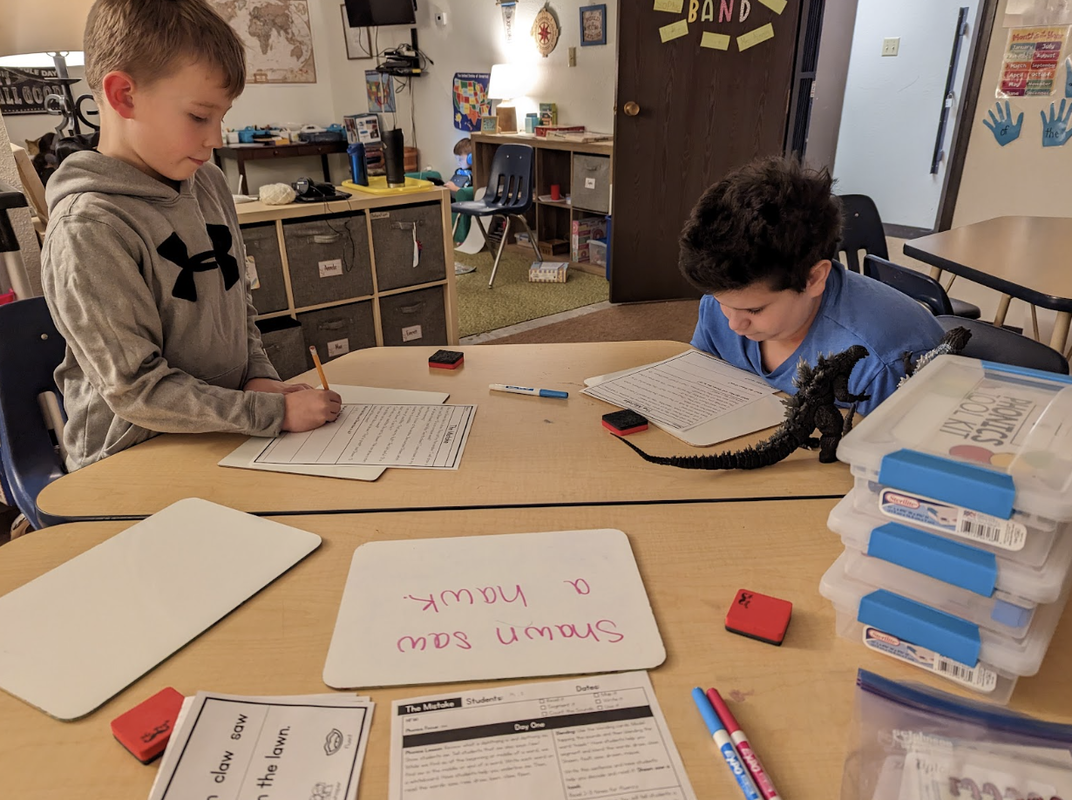|
As I began the school year co-teaching with Ms. Nancy, an amazing and experienced teacher, I was nervous, but excited. Prior to this, I had not been a classroom teacher. My background as a Speech and Language Pathologist for the past 9 years has included elementary schools and outpatient pediatric settings where I have worked one-on-one or in small groups with children with delays or disorders in speech and/or language. I reached out to Maggie Barth, The Innovation School Director, in Spring of 2022 to discuss how I could have a teaching role at TIS. My thinking was that I could grow my passion for the learning style at TIS while applying my skills that go-hand-in-hand with the classroom, especially in literacy. I thought with some tweaks in my approaches to working with children, I could teach within our smaller class sizes. Also, I have taken notice within the past few years in the world of education, much conversation around literacy instruction has been about structured literacy and the Science of Reading. One big area being highlighted is phonemic and phonological awareness skills, which are language skills. So for this post I thought I’d share my view on how speech and language skills are incorporated into my literacy instruction at TIS. I’ll include a few early literacy tips throughout for practice at home with your kids. Let’s start with speech. The simple way I would define speech is to verbally express thoughts in an articulate way. This includes mechanisms needed to make that happen including respiration(breathing), phonation(producing vocal sounds), and articulation(shaping sounds). This is at the basic level what is needed to produce speech. Now let’s pair speech sound production with phonology, which is the system of the rules and patterns of speech sounds in a language. Phonology includes phonemic awareness, which is the ability to recognize and take note of individual sounds in spoken words. Phonemic awareness tasks include: Syllable blending - oral skill of putting syllables together, going from part of whole say /nap/ + /kin/, what does that make “napkin” Syllable segmenting - oral skill of pulling apart syllable in words - say “snowman” without the man = snow Phoneme blending - oral skill of putting sounds together, /c/ /a/ /t/ to make “cat” Phoneme Segmenting - oral skill of pulling part sounds in a word - tell me the sounds you hear in “dog” - /d/ /o/ /g/. Phonemic awareness falls under the umbrella of phonological awareness, which is the ability to recognize and manipulate words and sentences including rhyming, number of words in sentence, syllables in word. A good way to think of it (I picked up from a recent training) is that phonological awareness is a skill that can be targeted in the dark, meaning it is done without any letters or words in front of you, a skill that can be practiced solely by listening. An at home tip to practice these skills would be games like the name game, clapping words in a sentence during book reading, or giving your child common directions in segmented productions such as go grab your “sh-oe-s” with individual sounds, and see if the child can identify the words. As a speech therapist, these skills are often targeted to help students better understand how to physically produce and recognize the patterns of word beginnings and word endings to increase awareness of how they are producing these sounds. As a teacher now teaching these skills to apply to reading, my approach is slightly different. I want the students to learn the phonemes (the sound that a letter makes) and then pair it with the grapheme (the written representation for that sound i.e. a letter or letters) to support sound-letter correspondence needed for decoding (reading) and encoding (writing). I encourage students to use their speech production by checking their mouth posture, tongue position, oral airflow to help them differentiate one sound to the next. This is a good way to practice at home when a child is learning, teach them the sounds and talk about what their mouth is doing for each sound (i.e, is it open or closed, where is your tongue, does the sound stop or keep going?). Within the Teal and Purple band, I am often reminding students that within our language we often hear fewer sounds than there are letters in a word. (Think of the silent e, the ph representing the /f/, the diphthongs, the vowel teams, all the different sound patterns that make up our language). Students learn strategies such as word mapping which includes identifying sounds they hear in a word, attaching meaning, tapping the sounds, writing the sounds(using previously learned phonics skills), blending, and reading. This sequence of steps is used to support learning of high frequency words with the less common spellings. Speech sound production and phonological awareness fit nicely together and play very important roles in learning to read and write. Similar to how speech sounds develop sequentially in young children, phonics skill development follows a sequence - short vowels, consonant sounds, blends, digraphs, silent e, r-controlled, vowel digraphs/diphthongs, affixes and multisyllabic words. I have found grouping students working on similar phonics skills has been the most effective way to target these skills. And this fits very nicely into meeting our kids where they are in their abilities, not grouping them by age or grade level. As we get further into this sequence, we begin to expand into other areas of language. Affixes and multi-syllabic words are where we begin addressing morphology, which is studying words by their parts or morphemes, which are the smallest units of meaning in language. This is a skill our Purple Band students are working on to support their reading, writing, and vocabulary development. This leads me into another topic for another post. Until then, I’m going to continue to learn and grow with our TIS students.
0 Comments
Leave a Reply. |
TIS StakeholdersA collection of thoughts, ideas and reflections from our educators, students, and families. Archives
September 2023
Categories |






 RSS Feed
RSS Feed
